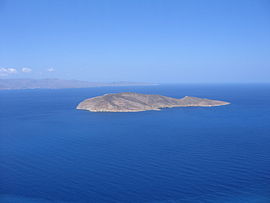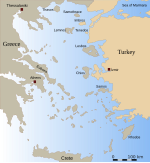Pseira
Pseira (Greek: Ψείρα) is an islet in the Gulf of Mirabello in northeastern Crete with the archaeological remains of Minoan and Mycenean civilisation.
[3] They did not enclose their planting sites, as the island's much later Byzantine practice was, a sign that goats did not roam free in Minoan Pseira; neither were pigs kept.
Dams collected seasonal run-off, for water was scarce on the island, though the Aegean region was less dry in the second millennium BCE than now.
Artifacts from the necropolis included clay vases, stone vessels, obsidian, bronze tools and jewelry.
"Cult practices involving large numbers of rhyta continued into successive periods in the Late Bronze Age, as is demonstrated by an interesting religious structure at Ugarit (modern Ras Shamra, Syria) with 15 rhyta, including Mycenaean and Minoan examples," Betancourt observes.





